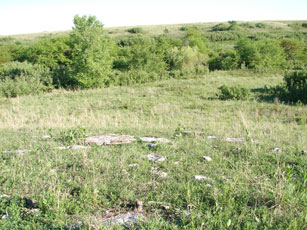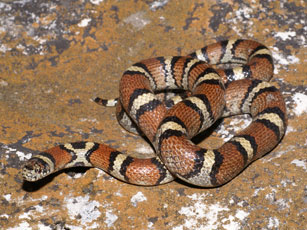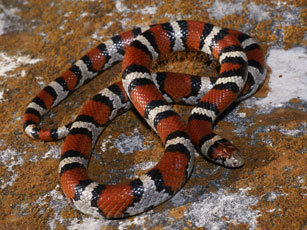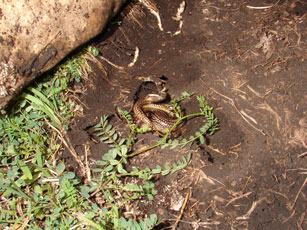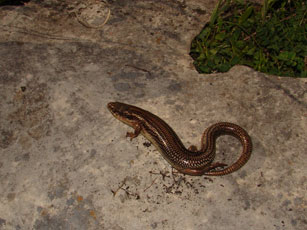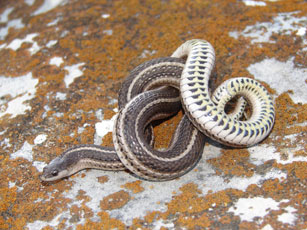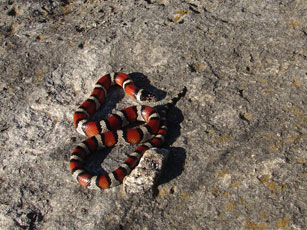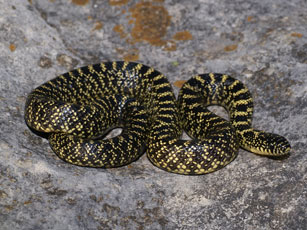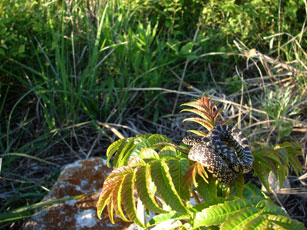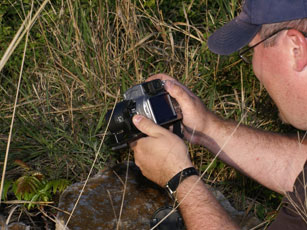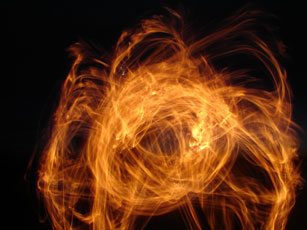
5-13-10
Trip Details
Weather: Sunny with little wind. 69 degrees.
Location: Geary County, Kansas
Herpers: Jim Scharosch & Matt Ricklefs
Account by: Matt Ricklefs
Photos by: Jim Scharosch & Matt Ricklefs
Thought of the Day: Welcome to the Flint Hills!
There are points along path previously taken that act as marker points, even when driving in a car. As we left Cedar Rapids, and hit Des Moines there is a certain series of curves on the interstate that make you feel like you are on your way to Kansas City. As you move into Kansas and continue west one of the stunning changes is the entry into the Flint Hills. It had been a fair drive and we were anxious to get some herping in as we were able to leave Iowa earlier than previously planned. The weather was nice and we had some sunlight left before we needed to make camp. Our first destination was of course, a hillside in the Flint Hills.
Photo by Matt Ricklefs
Our first find was a Milk Snake (Lampropeltis triangulum), a nice sized one at about twenty-eight inches.
Photos by Jim Scharosch
We were still in an area of the state where gentilis and syspila intergrade, so I will leave the description as general.
Soon after we scored another milk snake about thirteen inches long.
Photo by Jim Scharosch
It was a good start, and an expected one as milk snakes are the state snake of Kansas. Okay, that may not really be true and for sheer quantity I suppose the ringneck snake would win, but it is a state where milk snakes are very concentrated. While I am mentioning them, we did not take any ringneck snake pictures even though we did find several...hundred. Finding ringneck snakes in Kansas is like finding barbs on barbwire.
For some reason I did take a document shot of our next find, a Great Plains Skink (Eumeces obsoletus).
Photos by Matt Ricklefs
It was an adult at about seven inches. The first shot is at least an in situ shot and the second is a quick shot before it continued to bolt. Finding these in Kansas is almost like finding Ringnecks.
A species that really has no "flashiness" to it and yet always intrigues me is the Lined Snake (Tropidoclonion lineatum).
Photo by Matt Ricklefs
It does have a cool belly pattern and it is not extremely common in many areas. We did take a little time to get a few pictures of the one we found here. It was about six and a half inches. Sometimes they sit fairly well, other times they can be a pain. This one was fairly cooperative.
Next up was another Milk. It was a juvenile this time, a little shorter than the Lined Snake we had just photographed.
Photo by Matt Ricklefs
Shortly after this we found our first Speckled King Snake (Lampropeltis getula holbrooki).
Photo by Jim Scharosch
It was about twelve inches. This one actually posed quite nicely. So well in fact I had a little fun.
First Photo by Matt Ricklefs, second by Jim Scharosch
Contrary to what you see in the picture, King Snakes are not prone to crawl up small treelings and sit like a tree viper. It did make a fun shot though.
Our last find was another juvenile Milk not much larger than the last juvenile we found.
Photo by Jim Scharosch
This one was in shed so we took only a few shots for documentation.
The sun had been gradually getting lower and lower on the horizon but we still had enough twilight to set camp and relax with a few beers. I tried to take some night shots, but only managed a cool abstract fire picture.
Photo by Matt Ricklefs
The drive was long, but we were in Kansas and ready for a few days of...happy herping.

